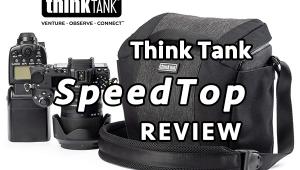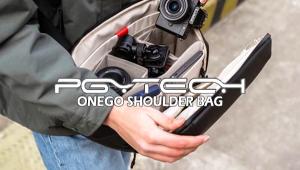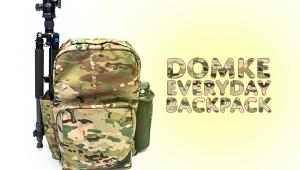How To Buy a Camera Bag

Photo bag and camera backpack designs are compromises. Like making a bed with a sheet that’s too small, if one side is tucked in, a different side is uncovered. With that in mind, here are 10 things to look for when you're shopping for a new camera bag.
We can’t call them simply “gadget bags” any longer; there are too many variations for all your photo gear, including shoulder camera bags, photo backpacks, sling packs, waist packs, attaché cases, messenger bags, rollers, hard-shell cases, armored travel cases, and more. I call them camera “carrying solutions” and even that’s not exactly right.
Each type of photo bag has its advantages and disadvantages, and every category has seemingly countless products to choose from. Unless you’re a careful shopper, you could end up with something that doesn’t truly suit your needs. Or worse yet, you might take a pass altogether out of sheer frustration.
Here’s help. This list of 10 characteristics should lead you to the general type of camera bag you need. And it may alert you to some options you never thought about before. This list is in no particular order because what’s important to me may not be important to you at all.
1. In and Out
There are two things that must be considered before any other step in the decision making process. What’s going to go into the bag? Where will the bag itself go?
Do you plan to pack a laptop or/and tablet? How about a drone? Need to carry your DSLR with a 70-200mm f/2.8 zoom attached? Would it be convenient if you could lash a travel tripod to the bottom or back? Do you inanely carry your cellphone and house keys inside the pack (a practice I strongly discourage)?

And where will you take the bag? If you intend to travel by air, be aware that carry-on restrictions generally limit size to 9 x 14 x 22 inches (22 x 35 x 56 cm) but check with your carrier because some airlines differ. Going to use it mostly when in the car? If so, does it fit between the front seat and firewall, or must it ride in the trunk?
If you plan long hikes or overnight outdoor trips, buy a bag that rides well for long periods of time and can withstand the elements. Many come with a rain cape of some sort or another.
Within the context of in and out, do you intend to use the bag outside the realm of photography? In other words, do you need a carrying solution that can double as an overnight bag, office attaché or fishing tackle box? If so, do you need room for a raincoat, umbrella or Manduka yoga mat?
2. Comfort
Hard, sharp corners bruise hip bones; thin shoulder straps cut grooves in your trapezius (shoulder) muscles. Imagine yourself wearing or carrying the backpack or bag for a full day. This is one of the big reasons why buying a bag or backpack online is like ordering perfume from a picture in a catalog—some things are hard to accurately imagine.
Comfort includes evaluation of empty weight, too. A backpack that weighs 12 pounds before you load it is probably a poor choice for most.

My pet peeve is strap slip. If the strap on a bag (or camera for that matter) is slick and refuses to stay put on your shoulder, move along and avoid the inevitable heartache. There are aftermarket solutions, sure, but better bags have shoulder pads or friction strips that prevent slippage.
3. Accessibility
How easy is it to retrieve your gear from the bag? This question is especially important when selecting a backpack. Some packs can be swung from behind you to the front and opened from their side, thereby providing easy access to the innards. Beware of backpacks that must be completely removed from your person to be opened. Typically, backpacks that open only from the back (i.e., the padded side where the shoulder straps attach) are the hardest to access. However, for the very same reason they offer a greater level of theft deterrent because no one can possibly unzip the bag from behind you without your knowledge. So once again, it’s a tradeoff.

The number and design of the internal dividers or partitions are also important. Most bag makers provide enough organizers, but some are fitted with hook-and-loop (Velcro-type) fasteners that grip so firmly that you literally work up a sweat pulling them out and repositioning them into the best configuration.
4. Capacity
Nowadays bag manufacturers often indicate the cubic volume in liters (L), and sometimes incorporate the liter volume in the name or model number of the bag. A liter is a measure of volume, and equals 61.02 cubic inches. An object 4 x 4 x 4 inches has a cubic volume of 64 cubic inches. Most of us are rotten when it comes to estimating size. How big is a Rubik’s Cube?

How many bodies? How many lenses? How many sandwiches and/or Cliff bars? If you must err in one direction or the other, buy a bag that too big.
And what about the flap-covered pockets on the ends and front? Will they hold your flash unit, Platypod or other necessities? Or are they smallish and flat and nearly useless?
5. Protection
How thick is the padding, and does it easily yield or does it stand up to a firm pinch? Think it can shield its contents through a tumble down a flight of stairs? Check the nature of the padded dividers, too. If they feel like fabric-covered cardboard, they’ll probably just transfer the shock of impact instead of absorbing it.
What is the color and texture of the lining? It’s easier to find a lens cap or hot shoe cover against an orange or yellow bag lining than against gray or black. Smooth, slick nylon surfaces are okay, but plush or soft microfiber linings are less likely to scratch LCDs and unprotected lenses.
Weather resistance is critical for most, unless you live on a dry planet like Mars. Many bags include a rain cover of some sort, and many repel water to one degree or another. However, if you need something that will endure a monsoon or the top of Mt. Washington, better opt for a bag that’s optimized for foul weather.

A few newer bags offer insulated areas that protect credit cards and other objects from malefactors who try to siphon out the RF signal and steal your identify information. This is a real threat and if you’re concerned, consider a wallet or card holder with RFID blocking. A wallet safeguards the items that need protection and lets you keep them in your pocket where they belong. Don’t forget that some hotel keys are RFID hotbeds, too.
For many people, protection seems like the most important characteristic. After all, what good is a gadget bag that doesn’t protect your gadgets? Well, hold on a second. Remember that the best bag for you ultimately is a balance of pros and cons. Sometimes you have to lose absolute protection for maximum accessibility, as in the case of the thin-walled but uber-accessible Domke F2 bag (one of my personal favorites, BTW).
6. Cosmetics
There is no accounting for taste. Select bag aesthetics that fit your style and personality. That said, you still might want to ask yourself a couple questions.

Are you the type who prefers a carry solution that flies under the radar, or someone who wants to proudly display the name of their favorite camera manufacturer? That’s the first thing to think about when pondering the cosmetics. A simple, plain Jane shoulder bag in black ballistic nylon attracts less attention. Someday bag makers will wise up and offer bags that have “Dirty Diapers” emblazoned on the front.
7. Durability
Frankly speaking, I have seen more bags that were filthy beyond belief than bags that simply wore out. I’ve worn small holes in a few (holes that were easy to repair with iron-on denim patches) but even that’s been rare. Even though today’s bags are built to provide a long service life, here’s what to look at.
Exterior material—in addition to shedding rain and snowflakes, does it resist abrasions and snags? Some textured cloth attracts dirt and grime. Can it be cleaned easily? Is the bottom coated with a durable material or at least reinforced?

Seams—straight and double-stitched, or can you see gaps in the sewing when you stretch the fabric very tight? Have loose threads been dressed or do they dangle precariously, waiting to be unraveled?
Hardware and zippers—is the hardware sturdy and nicely finished? While I wholeheartedly prefer YKK zippers, there are other brands that are acceptable. But make sure that the zipper pull-tab, slider and elements (teeth) are strong and glide smoothly.
8. Innovation
You may not be looking for innovation, and that’s understandable. Most of the outstanding bags I encounter are not what I’d call innovative, although there are a few that truly are original and ground-breaking.

In this category I also place environmental impact. I prefer to stay out of this argument, but some groups maintain that PVC, including the kind used sometimes in bag manufacture, is harmful and should be avoided. I think it’s fair to say that bags made of natural materials like leather, cotton canvas and even stinging nettles are safe bets for the ecologically inclined.

9. Price
It’s easy for me to say this because I don’t walk in your mukluks, but you really must consider cost of ownership over the entire lifespan of the bag or backpack, rather than only looking at the initial outlay. $300 may seem like a lot to pay for a messenger bag or photo backpack, but if you are going to use it for 15 years or more, that’s only—you can do the math. High quality bags last a lifetime.

10. Intangibles
There is something about the touch and smell of genuine leather that makes owning a cowhide bag more enjoyable. Over time, leather develops a unique patina and shows its wear like lines on an old man’s face. On the other hand, the soft graying canvas of my Domke F2 bag has a familiarity that feels natural and instills confidence.
Odds are you will like—or dislike—certain bags for reasons that you can’t articulate. No problem. In the long run, we all buy what we like best, anyway.
—Jon Sienkiewicz
















































